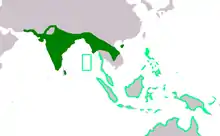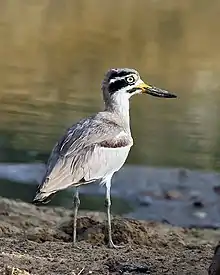Esacus
Esacus is a genus of bird in the stone-curlew family Burhinidae. The genus is distributed from Pakistan and India to Australia. It contains two species, the great stone-curlew and the beach stone-curlew.
| Esacus | |
|---|---|
 | |
| Beach stone-curlew (E. magnirostris) | |
| Scientific classification | |
| Kingdom: | Animalia |
| Phylum: | Chordata |
| Class: | Aves |
| Order: | Charadriiformes |
| Family: | Burhinidae |
| Genus: | Esacus Lesson, 1831 |
 | |
Description
The two species are larger and heavier-set than the stone-curlews of the genus Burhinus. They resemble small bustards, especially in flight, and have long and heavy bills and long legs.[1]
Distribution and habitat
The beach stone-curlew is found in coastal areas, as its name suggests, seldom found far from the coast. The great stone-curlew also favours water, often found close to large lakes or on the river shore. Like the Burhinus stone-curlews the great stone-curlew is nocturnal, but the beach-stone curlew is less so, and feeds during the day on beaches and islands.[1] The beach curlew is found from the Andaman Is through Indonesia to Australia and New Caledonia.[2] The great stone-curlew is found from coastal Iran and Pakistan through central India, Burma, Thailand to Hainan in China.[3]
Behaviour
They feed on crabs and other invertebrates; the great stone-curlew uses its large bill to overturn stones to find prey, and the beach stone-curlew uses its bill to break up crabs and eat them, which it catches by stalking them like a heron.[1]
The Esacus stone-curlews make harsh wailing calls. The great stone-curlew is a seasonal breeder, timing it before the start of the monsoon. The timing of the beach stone-curlew is more variable across its large range.[2] The beach stone-curlew is the only member of the family not to lay a clutch of two or three eggs, and lays a single egg.[1]
Status

Both species are listed as near threatened by the IUCN. They are threatened by habitat loss, introduced predators and disturbance of their breeding habitat.[2][3]
Species
- Great stone-curlew, or great thick-knee (Esacus recurvirostris)
- Beach stone-curlew, or beach thick-knee (Esacus magnirostris)
References
- Hume, R. & Bonan, A. (2017). Thick-knees (Burhinidae). In: del Hoyo, J., Elliott, A., Sargatal, J., Christie, D.A. & de Juana, E. (eds.). Handbook of the Birds of the World Alive. Lynx Edicions, Barcelona. (retrieved from http://www.hbw.com/node/52241 on 12 March 2017)
- Hume, R., Kirwan, G.M. & Boesman, P. (2017). Beach Thick-knee (Esacus magnirostris). In: del Hoyo, J., Elliott, A., Sargatal, J., Christie, D.A. & de Juana, E. (eds.). Handbook of the Birds of the World Alive. Lynx Edicions, Barcelona. (retrieved from http://www.hbw.com/node/53774 on 12 March 2017).
- Hume, R. & Kirwan, G.M. (2017). Great Thick-knee (Esacus recurvirostris). In: del Hoyo, J., Elliott, A., Sargatal, J., Christie, D.A. & de Juana, E. (eds.). Handbook of the Birds of the World Alive. Lynx Edicions, Barcelona. (retrieved from http://www.hbw.com/node/53773 on 12 March 2017).